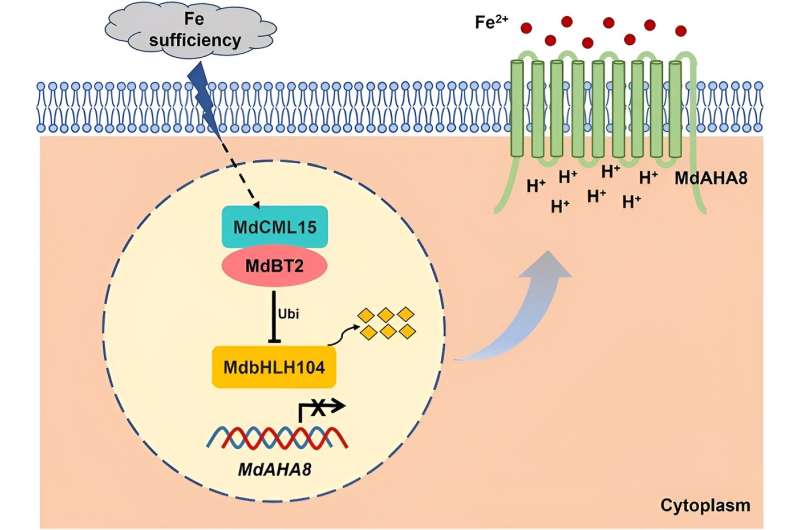This article has been reviewed according to Science X's editorial process and policies. Editors have highlighted the following attributes while ensuring the content's credibility:
fact-checked
peer-reviewed publication
proofread
Apple trees reveal key mechanism to unlocking iron homeostasis

Iron is a vital micronutrient for plants, essential for photosynthesis, respiration, and various metabolic processes. Despite its abundance in the soil, iron often exists in insoluble forms, particularly in calcareous soils, making it difficult for plants to absorb. This limited availability can severely impact crop yields and plant health.
Addressing these challenges requires a deeper understanding of iron uptake and regulation mechanisms in plants, which can lead to improved agricultural practices and the development of crops better suited to iron-deficient conditions.
Researchers from Nanjing Agricultural University have made significant strides in this field by exploring the interaction between a calmodulin-like protein and an apple-specific BTB domain protein, key to iron homeostasis. Their findings were published in the Horticulture Research journal on March 25, 2024.
The study demonstrated that MdCML15 functions as an upstream regulator of MdBT2, which is involved in the ubiquitination and degradation of MdbHLH104. This process results in the reduced expression of MdAHA8, a plasma membrane H+-ATPase crucial for iron uptake. Consequently, the interaction between MdCML15 and MdBT2 negatively affects the plant's ability to acidify the rhizosphere and absorb iron.
Transgenic apple plants overexpressing MdCML15 showed decreased iron uptake and severe chlorosis under iron-deficient conditions compared to wild-type plants. Conversely, plants with suppressed MdCML15 expression exhibited enhanced iron uptake and improved growth under the same conditions.
These findings provide new insights into the regulatory network of iron absorption in apple trees and highlight the potential of targeting MdCML15 to improve iron uptake in crops.
Dr. Chun-Xiang You, one of the corresponding authors, stated, "Our findings highlight the intricate regulatory mechanisms plants use to balance nutrient uptake and avoid toxicity. Understanding the role of proteins like MdCML15 in these processes opens new avenues for developing crop varieties with improved nutrient efficiency."
This research provides valuable insights into the molecular mechanisms of iron regulation in apple trees. By manipulating the expression of MdCML15, it may be possible to enhance iron uptake in crops, leading to improved growth and yield, particularly in iron-deficient soils. This knowledge can inform breeding programs and biotechnological approaches aimed at developing nutrient-efficient crop varieties.
More information: Xiao-Juan Liu et al, Calmodulin-like protein MdCML15 interacts with MdBT2 to modulate iron homeostasis in apple, Horticulture Research (2024). DOI: 10.1093/hr/uhae081
Journal information: Horticulture Research
Provided by TranSpread


















